Could Brewers ‘Sea of Parking’ Lots Be Developed?
Bucks, Packers have built restaurants, hotel, apartments. Brewers urged to do the same.
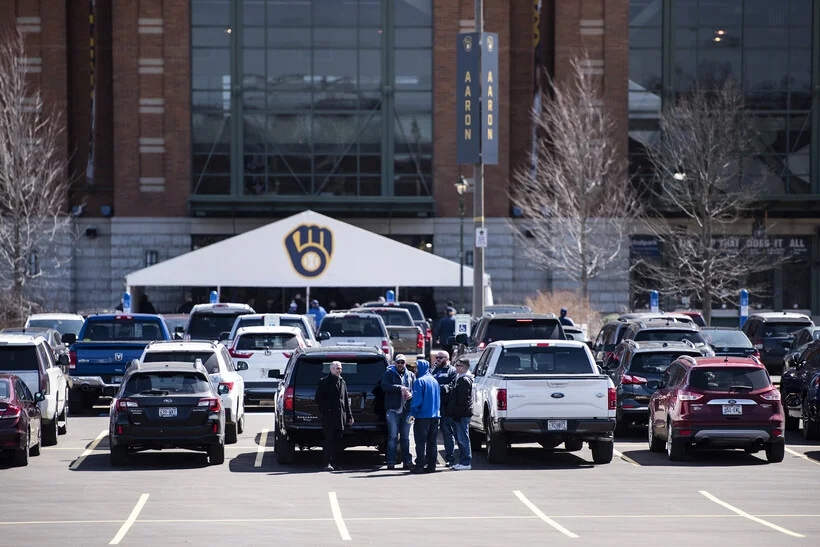
Fans gather before walking into American Family Field for the Brewers’ season opener Thursday, April 1, 2021, in Milwaukee. Angela Major/WPR
The aroma of grilled bratwursts and sound of baseballs hitting gloves over speakers playing “Beer Barrel Polka” are key to the pre-game experience for many Milwaukee Brewers fans, some of whom flood the parking lots hours before first pitch.
“American Family Field is surrounded by, and has been since 2001, a sea of parking,” Milwaukee Mayor Cavalier Johnson said. “I’d like to challenge the Brewers, to challenge that organization, to really consider, really push out, this idea of building a district around American Family Field and not to be surrounded by a sea of parking.”
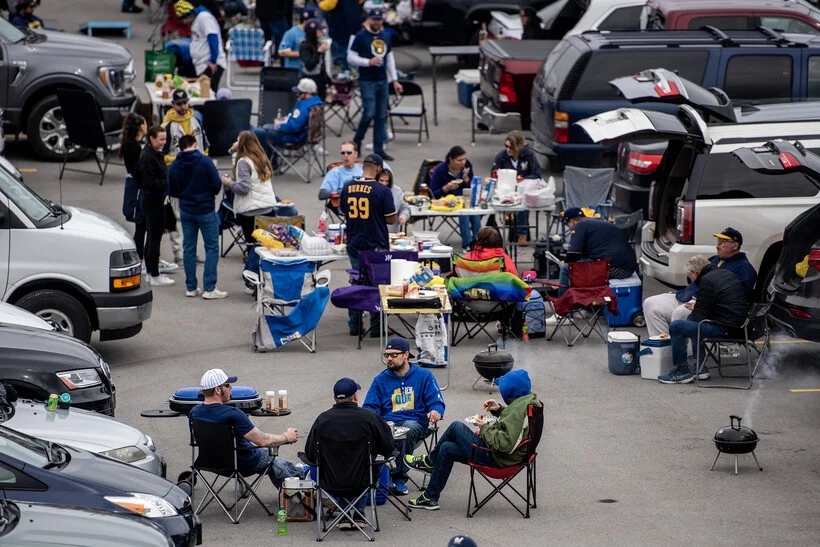
Tailgaters enjoy the mild spring weather before the Brewers’ home opener Monday, April 3, 2023, at American Family Field in Milwaukee, Wis. Angela Major/WPR
Some believe the land could have better uses, including space for restaurants and bars, hotels, apartment buildings and retail stores. That includes Robin Palm, an urban planner and representative for the Southeastern Wisconsin American Planning Association. Last year, he proposed the idea of building a “beer district” around the stadium.
Across the nation, there are several examples of developments and redevelopments spawning next to or around stadiums. The New York Mets owner announced an $8 billion plan last week to turn 50 acres of asphalt around the Mets ballpark for an entertainment district, public park space and athletic fields.
And in Milwaukee, there is another example just across town. The Bucks’ Deer District, which surrounds the Fiserv Forum, is lined with restaurants and commercial spaces, and includes a large plaza for community events and watch parties. In Green Bay, the Titletown District development next to Lambeau Field is the home of apartment buildings, hotels and restaurants.
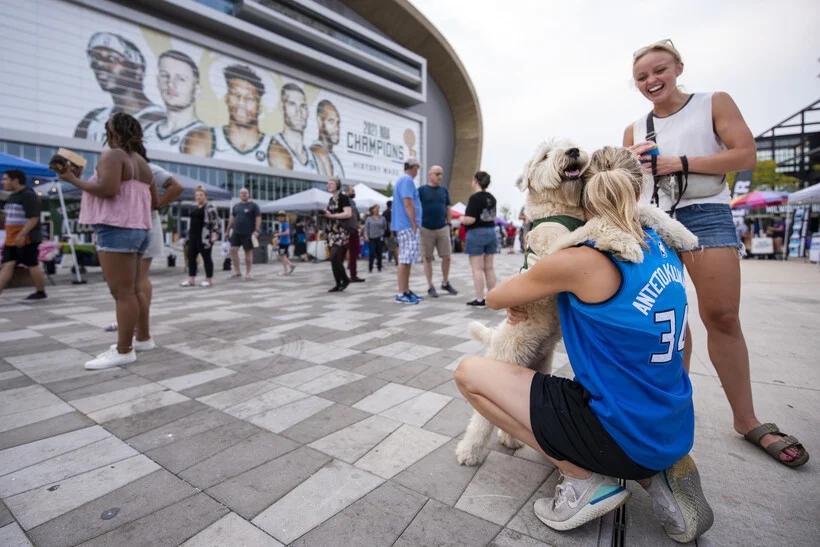
Mary Merg hugs her dog, Tucker, as they walk around the market Wednesday, July 28, 2021, at the Deer District in Milwaukee, Wis. Angela Major/WPR
Chad Venne, the director of the real estate program at the University of Wisconsin-Milwaukee, said he could see a combination of housing, retail, entertainment and hospitality uses at American Family Field, which seats over 45,000 fans.
“All of those would have to be really done in a complimentary fashion to one another, rather than just a one-off development in a parking lot,” Venne said.
“Can real estate development coexist with our tailgating culture and with our parking? Yes, but the devil is in the details,” Schlesinger said during an October public hearing.
Rep. Robert Brooks, R-Saukville, said a local advisory board could be created to look at ways to develop the parking lot and the land around the stadium. That’s something Schlesinger has said he’s open to as well.
“If we’re going to do it, it’s our exclusive property. If it makes economic sense, we would like to do it. If it makes no economic sense, it would be a fool’s errand to do it,” he said.
Schlesinger has expressed a few concerns about development however, one being protecting tailgating. During more popular games, he said the parking lot is often full.
“The Brewers experience is not just coming to the games and hopefully watching us win, it’s the tailgating beforehand,” Schlesinger said.
Schlesinger has also said he’s worried any development will add to traffic problems, as some fans have complained about the time it takes to leave the stadium after games. But Palm said that’s something development — which could offer an “alternative to tailgating” — could fix.
“If there was something to do right there, they wouldn’t necessarily have to leave right away,” Palm said. “You’re easing your traffic problem by giving things to do around the stadium.”
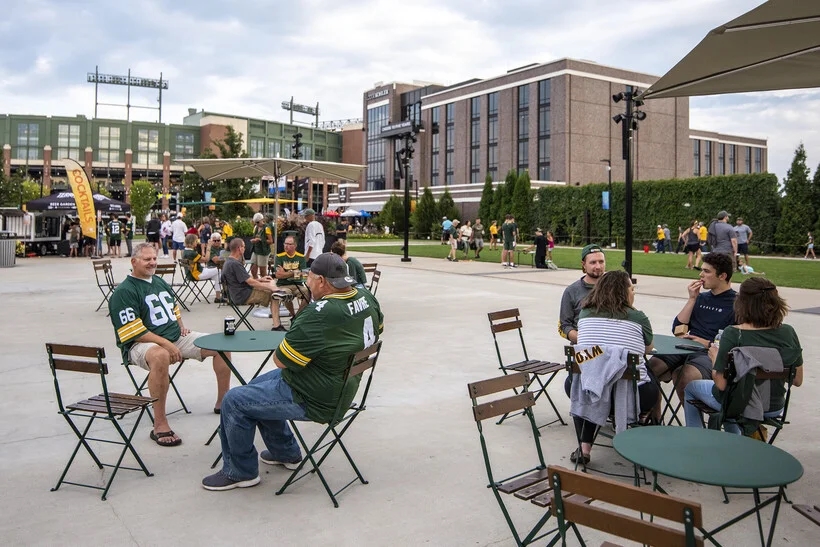
Packers fans sit in the Titletown District in Ashwaubenon before a preseason home game Friday, Aug. 19, 2022. Angela Major/WPR
Venne also said more opportunities before or after games could help with traffic concerns.
“When you have 35,000 people all let out of a stadium at once, and they have nowhere to go but their cars into a freeway on ramp, you’re essentially not giving anyone an option but to be sitting in traffic,” Venne said.
“If they become these year-round destinations, it really opens up a lot more potential for teams to stay relevant and stay on their fans’ radar throughout the entire season,” Venne said.
Other issues Schlesinger has mentioned include the potential need for environmental remediation at the site because it was built on a landfill. And unlike the Deer District, Schlesinger said, the stadium isn’t located downtown in an area with a dense population. And there is a lack of public transit to the site.
“I’ve got challenges of having enough of a population that can access it,” Schlesinger said.
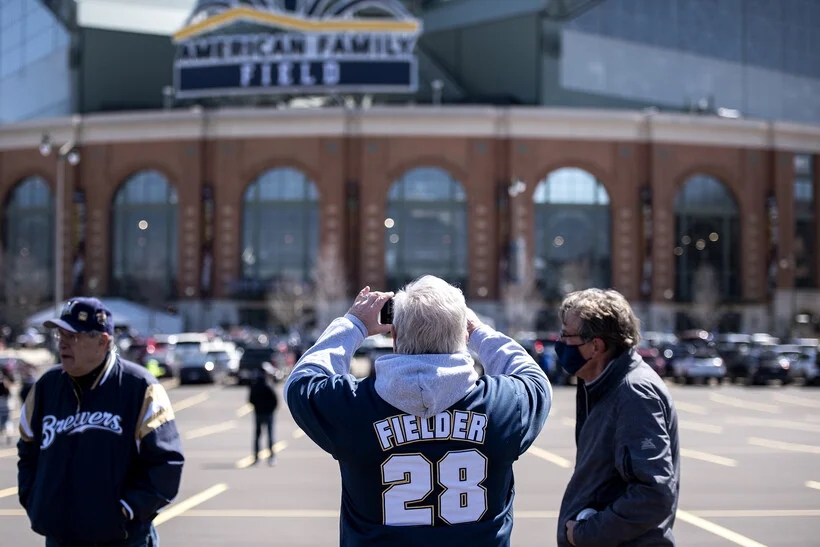
A fan takes a photo of American Family Field before the Brewers’ season opener against the Twins on Thursday, April 1, 2021, in Milwaukee. Angela Major/WPR
“I think it’s important that everybody work to come up with a creative complimentary plan that includes the communities surrounding the stadium, the organization itself, and the city, but recognize that these things take a lot of time, that they take a lot of time to do right,” Venne said.
The Legislature’s powerful budget committee voted 15-1 in favor of the stadium funding plan Nov. 8. The full Senate could vote on it as soon as this week.
Listen to the WPR report here.
‘Sea of parking:’ Could land around Milwaukee Brewers stadium be home to future development? was originally published by Wisconsin Public Radio.
More about the Miller Park Stadium Tax
- Stadium Authority Seeks Study to Redevelop Brewers Parking Lots - Jeramey Jannene - May 28th, 2025
- $54.9 Million in Upgrades Approved for Brewers Stadium - Evan Casey - Jan 28th, 2025
- MKE County: Brewers Ballpark Subsidy Stings County Budget - Graham Kilmer - Jul 28th, 2024
- Governor Signs Brewers Subsidy Agreement At American Family Field - Evan Casey - Dec 5th, 2023
- Gov. Evers Signs Bills to Keep Milwaukee Brewers, Major League Baseball in Wisconsin Through 2050 - Gov. Tony Evers - Dec 5th, 2023
- Council, Mayor Bickered On Brewers Deal - Jeramey Jannene - Nov 29th, 2023
- Brewers Stadium Deal Passes the Legislature - Shawn Johnson - Nov 14th, 2023
- County Executive David Crowley’s Statement on Bipartisan Bill to Keep Brewers in Milwaukee - County Executive David Crowley - Nov 14th, 2023
- Gov. Evers to Sign Bipartisan Plan to Keep Milwaukee Brewers, Major League Baseball in Wisconsin Through 2050 - Gov. Tony Evers - Nov 14th, 2023
- A swing, a miss, and an errant bat in the stands - State Sen. Chris Larson - Nov 14th, 2023
Read more about Miller Park Stadium Tax here






















Whatever one might think about a Beer District or stadium financing, Rick Schlesinger worrying aloud about traffic issues while looking out from his office over 160 acres of automobile storage is really…something.
It has always seemed short sighted that the Brewers never saw the potential for marketing the Team all year round.
They play 81 home games But that leaves 284 days for baseball fans to come to an entertainment district to buy T-shirts, eat at restaurants, tour the Stadium, enjoy a concert.
On that same theme – The Summerfest grounds seem grossly under utilized also – 3 weekends plus a few other special events? September to May – completely under utilized.
Hmmm? 12000 spaces available for 81 games $10 per space = $97 million in revenue!! Assume only 33% are used = $30 million + !! Any questions on why the “tail gating culture “ is so important! And remember no mass transit except for bar sponsored vans/buses! Hmm! Commercial development is a threat? As a brewer fan and season ticket group participant I’m somewhat concerned and embarrassed by the attitude of the brewers and their contribution to “their community “ which the ownership feels was dissed by Craig Counsell’s move to Chicago! This is an opportunity for them to show their support for that community through economic development and returning those “fields of fiery grills” to the tax rolls! Peace! TW